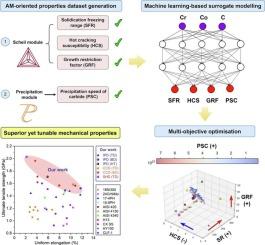Additive manufacturing metallurgy guided machine learning design of versatile alloys
IF 22
1区 材料科学
Q1 MATERIALS SCIENCE, MULTIDISCIPLINARY
引用次数: 0
Abstract
Additive manufacturing (AM) is distinguished by its near-net-shape fabrication capability, enabling single-step production of geometrically complex components. However, unlike conventional manufacturing processes, AM-fabricated parts generally lack post-process thermo-mechanical treatments. As a result, the performance of AM-built materials is predominantly governed by their composition and the thermal history inherent to AM. This underscores the necessity for developing materials dedicated to AM. To address this challenge, this study introduces an AM metallurgy-guided machine learning (ML) alloy design framework aimed at developing high-performance AM-specific alloys. The framework combines high-throughput thermodynamic simulations with ML surrogate models to predict key AM-oriented properties, including solidification freezing range, growth restriction factor, hot cracking susceptibility, and carbide precipitation speed. These AM-oriented properties are optimised through multi-objective optimisation and decision-making to design alloys with optimal AM performance. To validate this framework, pre-alloyed powders of a designed novel alloy were prepared and printed using various laser-directed energy deposition strategies. Comprehensive characterisations confirmed that the resulting microstructures and properties aligned well with the AM-oriented design objectives. Remarkably, the novel alloy exhibited superior yet highly tunable mechanical properties, with yield strength ranging from 1062 to 1769 MPa and uniform elongation varying between 2.1 % and 11.7 %, depending on the printing strategy. The superior yet tunable mechanical properties are attributed to the temperature-dependent phase transformations and rapid carbide precipitation kinetics of the novel alloy. Overall, this study establishes a robust data-driven framework for AM-specific alloy design, providing a powerful tool to reliably accelerate the development of high-performance and versatile alloys for AM.

增材制造冶金指导通用合金的机器学习设计
增材制造(AM)的特点是其近净形状制造能力,可以单步生产几何复杂的部件。然而,与传统的制造工艺不同,am制造的零件通常缺乏后处理的热机械处理。因此,增材制造材料的性能主要取决于它们的成分和增材制造固有的热历史。这强调了开发专用于增材制造的材料的必要性。为了应对这一挑战,本研究引入了增材制造冶金指导的机器学习(ML)合金设计框架,旨在开发高性能增材制造专用合金。该框架将高通量热力学模拟与ML代理模型相结合,以预测面向am的关键性能,包括凝固冻结范围、生长限制因子、热裂敏感性和碳化物析出速度。通过多目标优化和决策来优化这些面向AM的性能,从而设计出具有最佳AM性能的合金。为了验证这一框架,设计了一种新型合金的预合金粉末,并使用各种激光定向能量沉积策略进行了打印。综合表征证实,所得的微观结构和性能与面向am的设计目标很好地一致。值得注意的是,根据不同的打印策略,该合金的屈服强度在1062 ~ 1769 MPa之间,均匀伸长率在2.1% ~ 11.7%之间。优异的可调力学性能归因于新合金的温度相关相变和快速碳化物析出动力学。总体而言,本研究为增材制造特定合金设计建立了一个强大的数据驱动框架,为可靠地加速高性能和通用增材制造合金的开发提供了强大的工具。
本文章由计算机程序翻译,如有差异,请以英文原文为准。
求助全文
约1分钟内获得全文
求助全文
来源期刊

Materials Today
工程技术-材料科学:综合
CiteScore
36.30
自引率
1.20%
发文量
237
审稿时长
23 days
期刊介绍:
Materials Today is the leading journal in the Materials Today family, focusing on the latest and most impactful work in the materials science community. With a reputation for excellence in news and reviews, the journal has now expanded its coverage to include original research and aims to be at the forefront of the field.
We welcome comprehensive articles, short communications, and review articles from established leaders in the rapidly evolving fields of materials science and related disciplines. We strive to provide authors with rigorous peer review, fast publication, and maximum exposure for their work. While we only accept the most significant manuscripts, our speedy evaluation process ensures that there are no unnecessary publication delays.
 求助内容:
求助内容: 应助结果提醒方式:
应助结果提醒方式:


